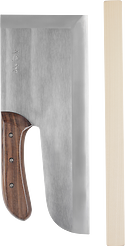Soba Knife
Delivering to US (Paying in USD)
Please note: By law, we are not permitted to sell a knife or blade to any person under the age of 18. By placing an order for one of these items you are declaring that you are 18 years of age or over. These items must be used responsibly and appropriately.
Product description
Mix the buckwheat dough, roll it, layer it, slice it. It looks so easy - providing you have the right knife. Although soba (buckwheat noodles) isn’t often made fresh in most homes these days, when you do get the chance to eat it, it’s the most delicious of all noodles. Trust us - we’ve eaten a lot of noodles. The New Year is classic soba-eating season, but zaru soba, on a bed of ice, keeps you cool in the heat of summer. This knife, with its long, heavy blade of Shirogami steel, cuts the soft dough into symmetrical noodles with a lovely, repetitive action. Comes with a Magnolia blade protector and a heavy canvas wrap cover, in a lovely, and very Japanese, box.
Best usage
Do be careful with the washing up.
More about Tadafusa
Tadayuki Sone, 3rd generation owner of Tadafusa, in his showroom in Sanjo.



